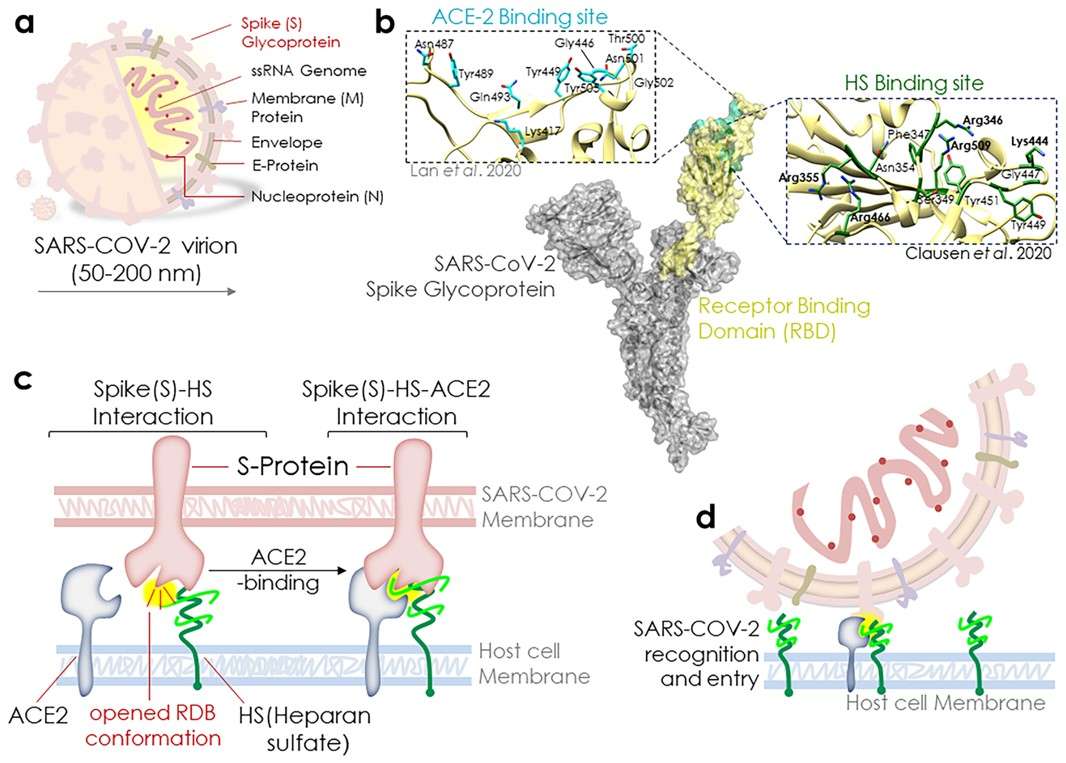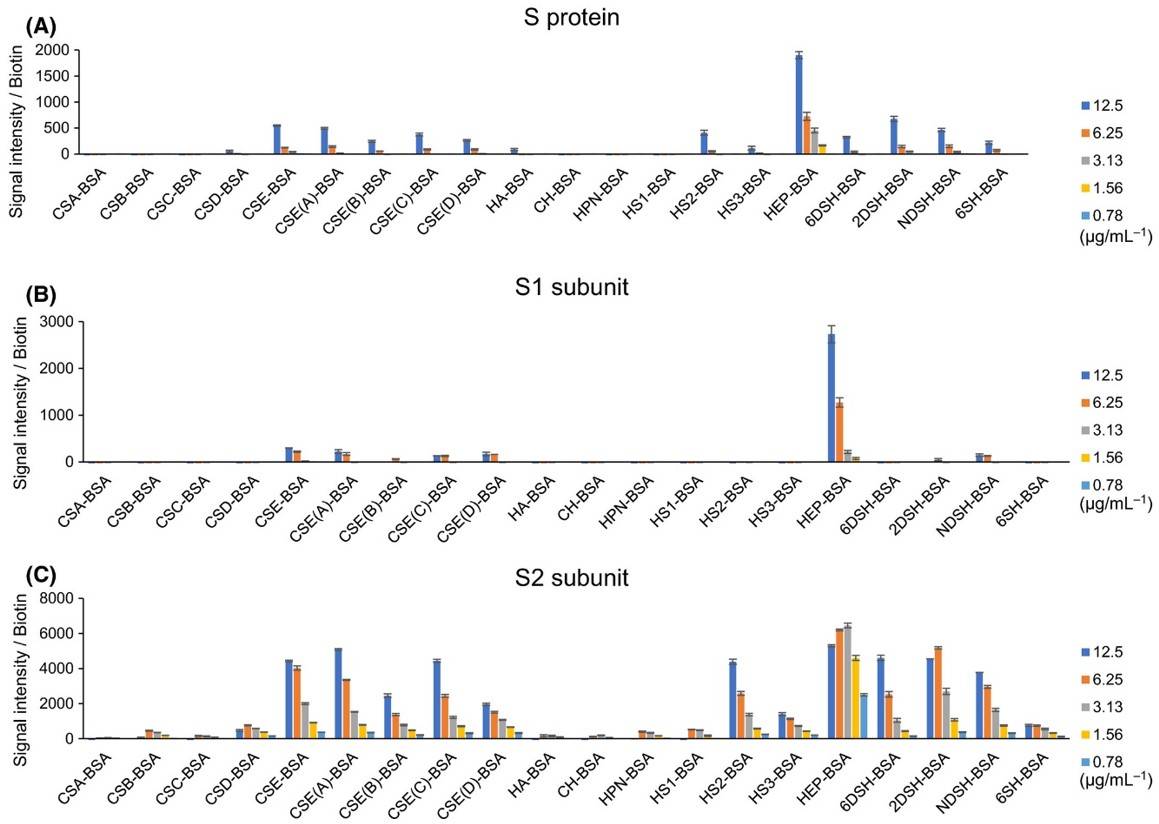Heparin Sulfate Microarray
Heparin sulfate (HS) is one of the most complex classes of carbohydrates that play a key role in regulating biological processes, including growth factor interactions, virus entry, and angiogenesis by binding to a host of proteins. Indeed, glycosaminoglycans have been shown to interact with a wide range of proteins, including growth factors, metalloproteinases, chemokines, and pathogenic proteins. Elucidating the sulfation specificities of the growing number of HS-binding proteins in the genome will be critical for understanding the structure-activity relationships of glycosaminoglycans and the molecular mechanisms underlying important biological processes. Creative Biolabs is a world-leading company that can provide the best microarray products and solutions for global customers in the field of protein research. Based on our established support platform including Lectin Microarray, MALDI-TOF MS, SPRi, TLC, and Flow Cytometry, we have completed many microarray projects and can provide the best products and services to customers all over the world.
Introduction of HS Microarray
HSs are linear O- and N-sulfated polysaccharides that reside on the cell surface and in the extracellular matrix of virtually all mammalian tissue types where they interact with numerous signaling proteins, growth factors and extracellular matrix components. HS chains are assembled by initially forming a linear polymer composed of alternating N-acetyl-D-glucosamine (GlcNAc) and D-glucuronic acid (GlcA) moieties. While, the incomplete sulfation and epimerization including N-deacetylation, N-sulfation and O-sulfation lead to the considerable structural complexity of HS.
Nowadays, it is widely accepted that HS is an information-rich polymer and alteration in HS expression has been associated with the disease. However, the structure-function relationships of HS and related proteins are very poorly understood due to the chemical complexity and heterogeneity of HS. The development of HS microarray can substantially improve the understanding of HS-protein interactions, opening an opportunity for the discovery of novel therapeutic interventions for a variety of disease states.
 Fig.1 HS is involved in SARS-CoV-2 spike protein infection.1, 3
Fig.1 HS is involved in SARS-CoV-2 spike protein infection.1, 3
Applications of HS Microarray
The interaction between HS and proteins is critical for many biological processes and related to various diseases. For example, significant changes in the composition of proteoglycans occur in the stroma surrounding tumors, which supports tumor growth and invasion. Many pathogens including bacteria, viruses, and parasites attack host cells by binding to HS, which is often a decisive factor for infection.
Some scientists have prepared a small library of synthetic HS oligosaccharides and built HS microarray chips that have been used to establish HS profiles for many HS-binding proteins such as fibroblast growth factors, natural cytotoxicity receptors, and chemokines. Taking advantage of the developed HS Microarray platform, we can screen the interactions between HS and various immunoproteins, as well as provide other services like Custom Synthesis, Anti-Glycoprotein Antibody Development, Tumor Glyco-diag Service, Glycan Modification and Labeling.
Creative Biolabs provides commercial and customized HS Microarray services according to your research goals. Please contact us for more details.
Publication data
HS is a linear sulfated polysaccharide that regulates a variety of disease and physiological processes. Its differential isomerization and changes in sulfation lead to structural diversity, which is thought to underlie protein binding and regulatory properties. HS is found to function as an essential host attachment factor in SARS-CoV-2 infection. To examine the sugar-binding specificity of SARS-CoV-2 spiny (S) proteins, a microarray containing HS and other glycosaminoglycans based on fluorescence detection was developed in this study. The S protein consists of two subunits, S1 and S2. By examining the binding properties of each subunit, the results showed that the S2 subunit binds to heparin, HS, and chondroitin sulfate E, while the S1 subunit showed a high degree of binding to heparin. The analysis of S protein subunit binding properties in this study helps to extend the understanding of the SARS-CoV-2 infection mechanism and also guides the construction of HS-based microarrays.
 Fig.2 Binding specificity screen for S proteins.2, 3
Fig.2 Binding specificity screen for S proteins.2, 3
FAQs
Q1: What is the biological significance of HS microarrays?
A1: HS is a sulfated glycosaminoglycan that plays a key role in various processes by interacting with proteins. The characterization of HS binding to target proteins is essential to study its functions and physiological and pathological processes. Microarray analysis based on natural or modified HS provides insight into the binding specificity of each protein and accelerates studies to understand the functions of HS in different biological contexts.
Q2: What is the construction process of HS microarray?
A2: The process of HS microarray construction mainly includes the following parts:
-
Construction of HS library: Natural HS is used to construct microarrays. In addition to this, various methods are developed to synthesize HS libraries, including the chemoenzymatic synthesis method, modular synthesis, and so on.
-
Preparation of HS microarrays: HS is spotted onto slides and incubated to achieve HS immobilization.
-
Microarray validation: The efficacy of the developed HS microarrays is validated.
-
Protein interaction analysis: Proteins containing fluorescently labeled proteins are incubated with the microarrays. The binding strength of the proteins to each sugar is determined by fluorescence intensity.
Q3: Are HS microarrays customizable?
A3: Of course, our team will customize HS microarrays for the analysis of HS interactions with various proteins according to the specific research goals of our clients.
Customer Review
Detailed HS Microarray Analysis Report
"Creative Biolabs utilized their HS microarrays to help us detect the interactions between HS and proteins. Their analysis report was very detailed and also provided reliable insights into the interpretation of the results. We are very satisfied with their high-quality service."
Attention to Detail in HS Microarray Analysis
"Throughout our collaboration with Creative Biolabs, we were very impressed with their attention to detail and expertise. Through their high-quality HS microarrays, we have effectively analyzed the binding specificity of proteins and advanced our research progress."
References
-
Kalra, Rajkumar Singh, and Ramesh Kandimalla. "Engaging the spikes: heparan sulfate facilitates SARS-CoV-2 spike protein binding to ACE2 and potentiates viral infection." Signal Transduction and Targeted Therapy 6.1 (2021): 39.
-
Watanabe, Tomoko, et al. "A glycosaminoglycan microarray identifies the binding of SARS‐CoV‐2 spike protein to chondroitin sulfate E." Febs Letters 595.18 (2021): 2341-2349.
-
Distributed under Open Access license CC BY 4.0, without modification.
For Research Use Only.

 Fig.1 HS is involved in SARS-CoV-2 spike protein infection.1, 3
Fig.1 HS is involved in SARS-CoV-2 spike protein infection.1, 3
 Fig.2 Binding specificity screen for S proteins.2, 3
Fig.2 Binding specificity screen for S proteins.2, 3



